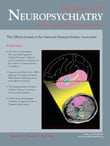Using Pramipexole in Neuropsychiatry: A Cautionary Note
SIR : Recent reports have recommended using the D2/D3 agonist pramipexole as a treatment for various psychiatric disorders such as depression in Parkinson’s disease, treatment-resistant depression and bipolar depression. 1 – 3 These reports have not adequately emphasized the psychiatric toxicity of pramipexole. While hallucinations have been described as side effects of pramipexole, 4 there are few reports of other psychotic symptoms such as delusions. A recent case report described delusional jealousy arising in the context of mania. 5 We report a case of acute nonaffective psychosis with delusional jealousy developing on pramipexole treatment of Holmes’ tremor, remitting on stopping the drug, relapsing on rechallenge with a lower dose and gradually remitting with complete stoppage.
Case Report
“Mrs. A,” a 37-year old Caucasian woman, had a subarachnoid hemorrhage 7 years ago from a basilar tip aneurysm following which she was left with a spastic hemiparesis in the right limbs, partial third nerve palsy, mild dysarthria and right-sided Holmes’ tremor. She had been taking daily doses of frusemide, 20mg, mirtazapine, 45mg, tizanidine, 12mg, and amantadine, 300mg, for several years. Three months prior to the current admission, a daily regimen of pramipexole, 2.1mg, was added and the dose increased to 2.8mg daily after 2 months. Three to 4 weeks after the increase in dose, she started hearing a buzzing sound that she associated with a mobile phone and muffled sounds which she identified as the voices of her husband and his brother. Later she developed the belief that her husband had bought a secret mobile phone because he was having an affair with another woman and was leaving the house to meet this woman as soon she fell asleep. On some occasions she acted on her belief, searching and confronting her husband repeatedly in an attempt to find the mobile phone and was verbally and physically aggressive at times. Later, she also experienced visual hallucinations, seeing her husband through her bedroom window. There were no symptoms of depression or mania. There was no alteration in consciousness and she was fully aware of time, place, and person.
There was no history of misuse of illicit drugs or alcohol. Physical examination did not reveal new findings. All laboratory tests were within normal limits. A urine screen for drug abuse was negative. As an initial measure, the regimen of pramipexole was stopped on admission. From the second day of admission, an improvement was observed. The frequency of the auditory hallucination decreased significantly with only two episodes, each lasting less than 1 minute, reported. No visual hallucinations, delusions or other psychotic symptoms were elicited. Pramipexole was reintroduced at 1.05mg daily and within a week, the buzzing sound and the delusion of infidelity recommenced. This led to further aggressive behavior, and therefore it was decided to stop pramipexole completely. In a few weeks the symptoms started to resolve and they finally disappeared in 2 months, although this was accompanied by a moderate worsening of the tremor.
Comment
As this patient was receiving another dopaminergic drug, amantadine, and mirtazapine, also reported to precipitate psychosis, at the time of onset of the psychosis, it is impossible to be certain that pramipexole caused the psychosis. But the temporal correlation with increase in dosage of the drug and the time course of improvement on discontinuation point to the involvement of pramipexole in the onset of psychosis. Psychiatrists need to be vigilant for the emergence of psychosis, particularly when using pramipexole in patients at risk for psychosis.
Iatrogenic psychiatric presentations may also serve as models for understanding the development of delusions. The content of psychopathology, the theme of jealousy in a married woman with severe and long-term physical disability, may be explained in psychosocial terms though not the form of the delusion itself. An overarching formulation to explain both form and content of psychopathology would be along the model proposed by Kapur, linking hyperdopaminergic states and aberrant salience attached to external objects and internal representations. 6 The study of drug-induced delusions may also be helpful in advancing our understanding of the cognitive neuropsychiatry of delusion formation. 7
1. Lemke MR, Brecht HM, Koester J, et al: Anhedonia, depression, and motor functioning in Parkinson’s disease during treatment with pramipexole. J Neuropsychiatry Clin Neurosci 2005; 17:214–220Google Scholar
2. Goldberg JF, Burdick KE, Endick CJ: Preliminary randomized, double-blind, placebo-controlled trial of pramipexole added to mood stabilizers to treat treatment resistant bipolar depression. Am J Psychiatry 2004; 161:564–566Google Scholar
3. Cassano P, Lattanzi L, Soldani F, et al: Pramipexole in treatment-resistant depression: an extended follow up. Depress Anxiety 2004; 20:131–138Google Scholar
4. Etminan M, Gill S, Samii A: Comparison of the risk of adverse events with pramipexole and ropinirole in patients with Parkinson’s disease: a meta-analysis. Drug Saf 2003; 26:439–444Google Scholar
5. Singh A, Althoff R, Martineau RJ, et al: Pramipexole, ropinirole, and mania in Parkinson’s disease. Am J Psychiatry 2005; 16:814–815Google Scholar
6. Kapur S: Psychosis as a state of aberrant salience: a framework linking biology, phenomenology, and pharmacology in schizophrenia. Am J Psychiatry 2003; 160:13–23Google Scholar
7. Gillen J, David AS: The cognitive neuropsychiatry of delusions: from psychopathology to neuropsychology and back again. Psychol Med 2005; 35:5–12Google Scholar



